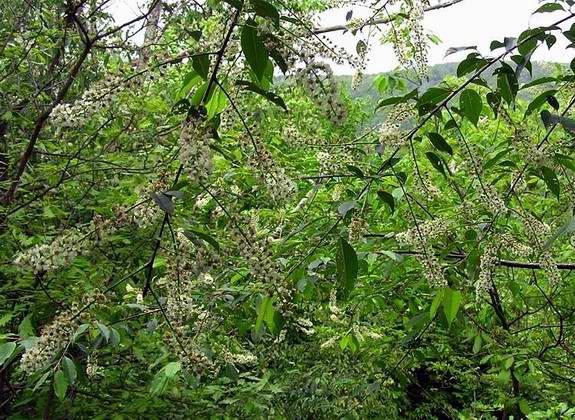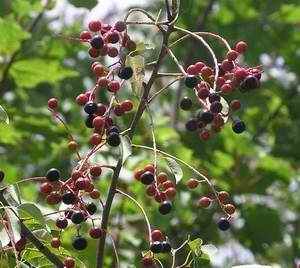|
Return to Hiker's Notebook Home Page
Common Name: Black Cherry, Wild cherry, Rum cherry, Mountain black cherry, Virginia prune - The Latin word for cherry tree, cerasus is from the ancient Black Sea city of Cerasos (it is now called Giresun and is in Turkey) which was noted for its fruit (cherry) trees. The Roman General Lucullus reputedly brought the "Cerasos" tree to Rome and is thus accredited with its subsequent spread to Europe. It became cherry in English as a derivative of the French word cerise. The North American variant is called black cherry because many of the fruits are very dark red to nearly black.
Scientific Name: Prunus serotina - The generic name means "plum tree" in Latin; the genus includes the plum, peach, and almond in addition to the cherry, all of which have drupes. Drupe fruits have a soft, fleshy mesocarp that surrounds a hard stone endocarp that encloses the seed. A serotinous plant is one that is late to reach full maturity; in the case of angiosperms, it applies to a delayed blooming of flowers. The black cherry tree flowers much later that other cherry trees; it is hence serotinous.
The Black cherry is not a major terminal tree in the progression of speciation that results in a mature forest, but rather a successional tree that thrives for a time and then succumbs to the competition for the canopy. This is because it is notable for its intolerance to shade. Though seedlings are abundant under a stand of uncut trees, they rarely survive beyond 3 to 5 years to the sapling stage. However, in some areas - notably the Allegheny Plateau between 1,000 and 2,600 feet which is why it is sometimes called mountain black cherry - the silvical conditions for its dominance or co-dominance prevail and relatively uniform stands can be found. Black cherry maintains its dominance from about 60 to 80 years, after which its mortality rapidly increases. The ample supplies of cherry wood that were available early in the 20th Century have been attributed to the fallow fields left after the Civil War; the cherry trees had about 80 years to develop.
Also known as the wild cherry is the largest of the native cherries and is the only one with commercial value as a timber tree; in the eastern United States, only the black walnut is more valuable. Growing to heights of up to 100 feet with a diameter of 5 feet, it has a very straight bole with few limbs and little taper; it accordingly yields large planks of blemish free wood. Its value is in its aesthetic appeal - the reddish-brown heartwood is revered for its beauty. It is widely used for cabinetry, furniture, veneers, musical instruments, and burial caskets, as it is fine-grained, bends well, finishes smoothly, is as strong as rock maple and nearly as hard. The rich glow of the wood is natural, turning from a light red when first cut to a deep mahogany-red on exposure to the sun. Its popularity in the colonies led to its importation to Europe; it is recorded as having been planted in English gardens as early as 1629, the name Virginia prune is associated with the Old World introduction.
Black cherry leaves contains the glycoside (sugar derivative molecule) called prunasin (from the genus Prunus) which is converted by the enzymes in the digestive system into hydrogen cyanide, which is toxic. This is primarily a problem with ruminant animals (cows, sheep and goats), though monogastric (single stomach) animals like horses and dogs are also affected. Due to its toxicity, farmers are generally advised to remove black cherry from areas adjacent to livestock pastures. Cyanide prevents animal cells from being able to absorb oxygen, so that, although the animal can still breath, it is unable to process it and essentially suffocates Symptoms include anxiety, respiration problems, staggering, convulsions, collapse and death. There are some possibly dubious reports of children dying after ingesting an excessive number of seeds from the cherry fruits.
Black cherry bark is a noted medicinal. The Meskwaki
or Fox Indians used the bark of the root to make a tea that was used as a
sedative. It was common practice among the
Appalachian Mountain people to steep strips of cheery bark in a jar filled
|

